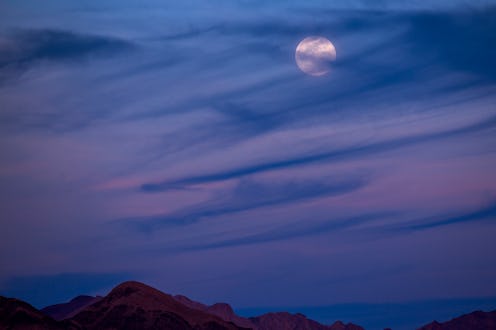
This summer has already gifted us with some special astrological activity, the most recent being the partial solar eclipse that happened on Jul. 12, when the new moon rose. For some lucky viewers, the end of the month will be even more exciting: there's a total lunar eclipse coming on Jul. 27 or Jul. 28, depending on location, and it's actually the longest lunar eclipse this century. That means that if you want the chance to really see it, this might be your best shot, because you'll have so much time before it disappears. So how can you see the July total lunar eclipse? Unfortunately, this is one phenomenon we won't all have the pleasure of viewing.
For those who are a little confused about the difference between a partial and total eclipse, or a solar and lunar eclipse, here's the quick and dirty. According to Space.com, "lunar eclipses occur when Earth's shadow blocks the sun's light, which otherwise reflects off the moon." A solar eclipse, on the other hand, is when the moon blocks the sun from view — we saw that in the summer of 2017.
There are three types of eclipses: a total, partial, and penumbral. A penumbral lunar eclipse is when the sun, Earth, and moon are imperfectly aligned, so the Earth blocks some of the sun's light from reaching the moon's surface and covers part of the moon or all of it. It's very faint, and is difficult to spot. A partial eclipse results in only part of the moon being covered, and a total eclipse is the most dramatic of all, when the Earth's shadow completely covers the moon. This is is what is happening on Jul. 27 and 28.
According to EarthSky, the total eclipse this month will begin during the night of Jul. 27 and the morning of Jul. 28, lasting one hour and 43 minutes. This is also called a "blood moon," which refers to when the moon travels through the darkest region of Earth's shadow (the umbra) and glows a reddish-orange color. On top of all of that, Newsweek says that Mars will also look especially large and bright as it will be the closes to Earth as it has been in 15 years. So, yeah, there is definitely a lot going on in the sky on this date!
So where can you get a view? Unfortunately for those of us in the United States, the eclipse will only be visible from the Eastern Hemisphere. Newsweek says it will be visible in Asia, Australia, New Zealand, and much of Europe and Africa. Some Western Hemisphere locations, like part of South America, might see it as well.
That's a pretty large area, and depending on the sky conditions, not everyone will get a perfect view. Time actually looked at the possible conditions of the sky and how long the eclipse is set to last, and found a areas that offer the best possible viewing spot. These include Cairo, Egypt; Limassol, Cyprus; Santorini, Greece; Dubai, United Arab Emirates; and Harare, Zimbabwe. If you live in these areas or happen to be vacationing at one of these spots during this time, you're in luck. You'll almost definitely be able to see the total lunar eclipse, which is undoubtably going to be amazing.
According to EarthSky, "the total eclipse will take place from 7:30 p.m. UTC (3:30 p.m. ET) until 9:13 p.m. UTC (5:13 p.m. ET). The Moon will be partially eclipsed for roughly an hour before and after the main event. The greatest eclipse will occur at 8:22 p.m. UTC (4:22 p.m. ET)." As for anyone in Australia or New Zealand, they'll have to wait until the morning of July 28th.
We won't be able to get a glimpse of the eclipse in the United States, so we'll just have to wait for the next one. If you really want to check it out, though, you can watch it via a livestream from the Virtual Telescope Project and timeanddate.com. The VTP stream starts at 2:30 p.m. ET and timeanddate.com's starts at 2:00 p.m. ET. It's not quite the same, but it will do!